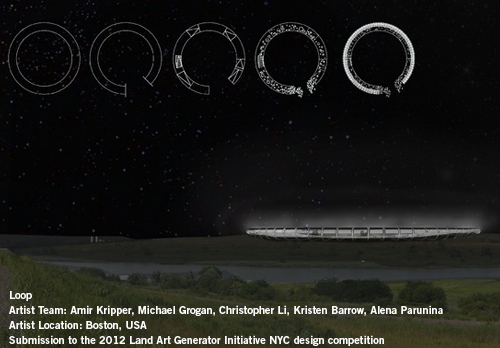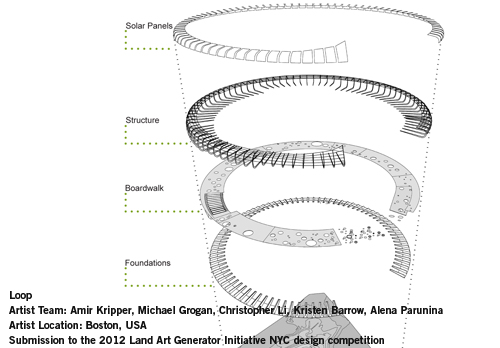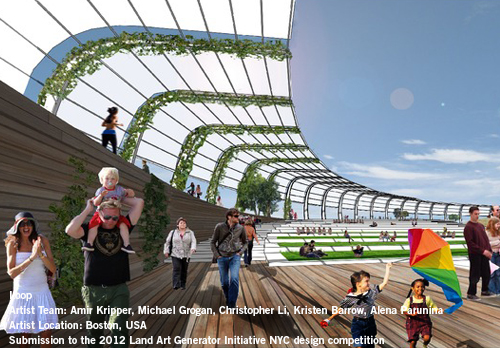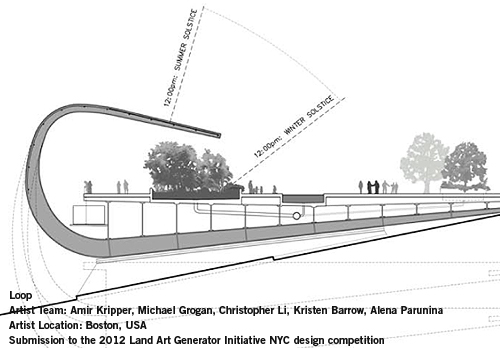Loop
Submission to the 2012 Land Art Generator Initiative NYC design competition
Artist Team: Amir Kripper, Michael Grogan, Christopher Li, Kristen Barrow, Alena Parunina
Artist Location: Boston, USA

Artist Descriptive Text:
1.Intro
The proposal for the Freshkills Park is a “Loop” that aims to dissolve the traditional boundaries between landscape, architecture, public art and renewable energy infrastructure. The project, located on the North Park, consists of a two hundred foot wide boardwalk, articulated by a number of vertical elements on which a system of flexible solar panels are mounted. Through a series of ramped manipulations, the installation corresponds to the unique topography of the site, mediating the slopes of the hill and providing spectacular vistas of the entire park.
The generous circular path loosely defines a journey while serving as a framework transitioning between the new and existing landscape. Along the walkway, a system of circular planters, that vary from five to sixty feet in diameter, are planted with indigenous flowers, plants and trees of Staten Island as well as exotic ones. In addition, circular pools collect rain water and the Loop foundation provides a runoff break allowing filtered water to return to the creek. The structure of the loop is articulated with steel I beams, or “ribs”, every fifty feet, supported by a light concrete mat foundation on grade. The flexible solar panels are arranged on a metal mesh with steel cables that span between the ribs.

A large open amphitheater is integrated into the wooden pathway, which can accommodate large events and live performances. The Loop is able to host diverse cultural, social and athletic activities year around as well as providing a unique space for learning, relaxing and playing.
2.Solar Energy
We based our calculation on the assumption that 1 MW of power will supply the energy needs of up to 1,000 homes with each home using about 10,000 kWh per year. A 1 MW utility grade solar plant will require about 6 acres of land. The installation will require 1 to 2 inverters (transformers) to convert the DC power from the solar panels into AC for household use and to safely connect to the local power grid. Inverters are designed for up to 1 MW. A second inverter is advisable given the size of this proposal in order to spread the inversion activity since inverters have to be replaced around every 10 years.
This proposal incorporates flexible lightweight solar energy modules on a metal mesh attached to steel cables spanning between the ribs. The installation is able to provide electricity to more than 1,200 homes. In addition to generating renewable energy, the 6.8 acres of flexible solar panels operate as a shading device for the walkway. The upper portion of the ribs are incrementally angled in order to optimize solar exposure at different orientations and the lower portion varies in accordance to the topography of the site.

3.Environmental Impact Statement
This proposal responds to the brief in terms of creating a macro installation that interacts creatively with the general public while generating large amounts of clean energy. However, its great size and scale, impacts the existing environment. In order to mitigate the effects of water runoff, circular planters placed on the walkway will collect the rain water which is filtered and returned to the creek. Also, special consideration was taken in preserving the integrity of the landfill cap as well as the hill by conceiving the installation as a light metal structural framework on a light concrete foundation mat on grade.
4. Summary
The goal for the Loop, ultimately, is to become a transformative experience where visitors are inspired after discovering the installation and engaging with the amazing views of Fresh Kills Park and Staten Island at large. Moreover, the aim is to establish the installation as a learning facility where the visitors interact with state of the art technology and renewable energy while discovering a new built environment. The Loop will be a unique place, a landmark, a sculpture in the landscape not only providing clean energy for New York City but engaging the public in the reinvented Fresh Kills Park in an unprecedented way.
